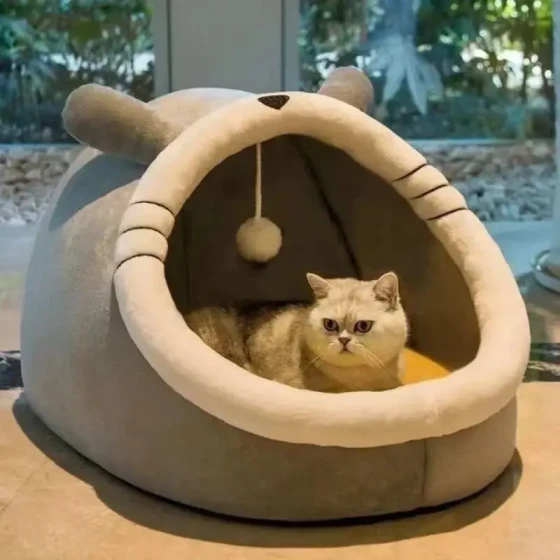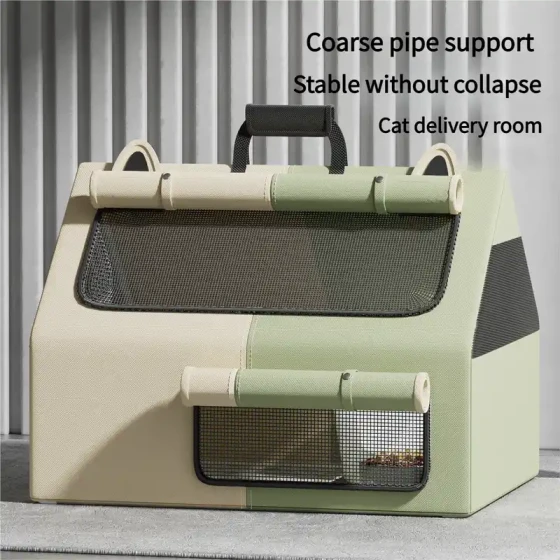Three States of Cat Thanatosis_Cat Thanatosis Symptoms and Identification Methods
When a cat suddenly collapses and appears lifeless, this is usually referred to as a "thanatosis" state, but in fact, it may be an emergency caused by multiple serious reasons that require us to quickly identify and take action. A cat's "thanatosis" is not true death but a stress response of the body under extreme circumstances, which may manifest as syncope, shock, or severe weakness. Understanding the symptoms and identification methods of these states is crucial for timely saving a cat's life.

There are three main cat states similar to "thanatosis":
- Syncope (Syncope): Refers to the cat's temporary loss of consciousness due to sudden insufficient blood supply to the brain. This state is usually sudden and may be accompanied by limpness or stiffness, and the cat may quickly return to normal after regaining consciousness.
- Shock (Shock): This is a more critical state, representing the failure of the circulatory system, resulting in tissue and organ hypoxia. Shocked cats typically have low body temperature, rapid breathing, pale gums, and may even enter a semi-comatose or coma state.
- Severe Weakness (Severe Weakness): The cat experiences severe energy depletion due to illness, poisoning, or other causes, showing symptoms like unstable standing, collapse, or dull responses to external stimuli.
Cat Thanatosis Symptoms and Identification Methods
Distinguishing these states and judging whether a cat is in danger requires careful observation of vital signs and accompanying symptoms.
Symptoms and Identification of Syncope
Syncope is a temporary loss of consciousness in cats, similar to humans fainting due to a sudden drop in blood pressure. In cats, syncope may present as:
- Sudden collapse and loss of consciousness. The body may be limp when falling, sometimes accompanied by brief stiffness or convulsions.
- Rapid recovery of consciousness. In most cases, cats regain consciousness within seconds to minutes and may quickly stand up as if nothing happened.
- Possible accompanying symptoms: Before syncope occurs, cats might show brief weakness, unsteady gait, or confusion.
Key identification points: The briefness of loss of consciousness and the usual rapid self-recovery. Observing the situation when syncope occurs, such as if it happens after excessive excitement, stress, or vigorous exercise, helps determine the cause.
Symptoms and Identification of Shock
Shock is an extreme response of the body to severe trauma or illness and a sign of circulatory collapse. Cats in shock require immediate medical attention. Symptoms of shock are generally more severe and last longer than syncope:
- Severe depression or coma. The cat may be dull or completely unresponsive to external stimuli.
- Significantly lowered body temperature. The cat's ears, paws, and other areas feel cold to the touch.
- Abnormal color of gums and tongue. Healthy cats have pink gums, but during shock, gums may turn pale, white, or even bluish-purple, indicating severe tissue hypoxia.
- Rapid or shallow breathing. Breathing may become very labored.
- Weak or too fast/slow heartbeat. Pulse may be hard to detect.
- Cold limbs.
- Slow or no spontaneous recovery.
Key identification points: Shock is a systemic critical condition with dysfunctions in multiple systems, especially circulatory and respiratory. Gum color changes are important warning signs.
Symptoms and Identification of Severe Weakness
Severe weakness may be caused by various underlying diseases; although it may not cause loss of consciousness, the cat will show clear signs of physical exhaustion:
- Unstable standing or inability to stand. The cat may stagger, easily fall, or lie on the ground unwilling to move.
- Lethargy and loss of appetite.
- Dull responses to external stimuli. The cat might be less lively than usual and respond slowly to the owner's calls.
- Accompanied by other disease symptoms. Such as vomiting, diarrhea, pain, depending on the cause of weakness.
Key identification points: Although not as dramatic as syncope or shock, severe weakness indicates the cat's poor condition and requires identifying underlying causes and treatment.
Common Causes of Cat Thanatosis States
Various health issues may underlie cat thanatosis-like states. Understanding these helps in better prevention and response.
- Heart Disease: One of the main causes of syncope and sudden death in cats, especially hypertrophic cardiomyopathy. Abnormal heart function affects blood flow to the brain and organs, triggering syncope or shock. Some breeds, such as Maine Coon, Persian, and Ragdoll, have higher risks of congenital heart disease.
- Hypoglycemia: Low blood sugar leads to insufficient brain energy, causing weakness or even coma. More common in kittens and cats with diabetes or liver disease.
- Respiratory Problems: Severe breathing difficulties cause hypoxia, leading to syncope or shock. Diseases like asthma and pneumonia can affect respiratory function.
- Poisoning: Cats ingesting toxic substances, such as certain plants, chemicals, or medications, may suffer nervous system or organ damage, causing convulsions, coma, or shock.
- Nervous System Disorders: Seizures, brain injuries, or diseases may cause sudden collapse or loss of consciousness.
- Severe Pain or Stress: Extreme pain, fright, or stress affects the nervous and cardiovascular systems, leading to syncope or collapse.
- Environmental Factors: High temperatures may cause heatstroke, leading to shock.
What Can I Do When a Cat Is in Thanatosis State?
When a cat suddenly collapses, owners may feel helpless, but staying calm and taking appropriate actions is critical.
- Stay calm and observe. Try to note the cat's symptoms during the episode, such as duration, presence of convulsions, and breathing condition. If possible, record a video on your phone, which is very helpful for veterinary diagnosis.
- Check breathing and heartbeat. Gently touch the cat’s chest or femoral artery to feel for heartbeat and pulse. Observe the chest for rise and fall to determine breathing.
- Ensure airway is clear. Gently pull out the cat's tongue and check the mouth and throat for obstructions blocking the airway.
- Keep warm. If the cat’s body temperature is low, wrap it in a blanket or other items to keep warm.
- Seek immediate veterinary care. Whether the cat recovers consciousness shortly or not, take it to the nearest animal hospital immediately. Even if seemingly recovered, underlying health issues may need diagnosis and treatment.
Important tips:
- Do not force-feed or give water. Forcing food or water when the cat is unconscious or weak may cause choking or aspiration.
- Do not move unnecessarily. Unless to move the cat to safety or a ventilated area, minimize unnecessary handling to avoid worsening the condition, especially suspected fractures or internal injuries.
- Do not medicate by yourself. Never give any medication without veterinary guidance.
Preventing Cat Thanatosis States
Although some emergencies are unpredictable, careful daily care and health management can reduce the risk of severe health problems.
- Regular check-ups: Annual comprehensive health exams, especially for senior or certain breed cats, help early detection of heart disease, kidney disease, diabetes, and other issues.
- Provide balanced nutrition: Choose high-quality, nutritionally comprehensive cat food, ensuring adequate taurine and other essential nutrients vital to heart health.
- Ensure environment safety: Properly store toxic substances and avoid exposing cats to harmful plants. In summer, prevent heatstroke by avoiding prolonged exposure to high temperatures.
- Reduce stress: Provide a safe and comfortable living environment, avoid frequent moves or exposure to stressful people or animals. If anticipating stressors (e.g., firecrackers), consult a veterinarian in advance for anxiety relief measures.
- Closely monitor daily behavior: Understand the cat’s normal eating, drinking, elimination, activity, and sleep patterns. If abnormalities like reduced appetite, lethargy, or changes in breathing appear, stay alert and consult a veterinarian.
Frequently Asked Questions
- Q: What is the difference between cat thanatosis and sleeping?
A: Sleeping cats usually breathe steadily and respond to external sounds or touch (e.g., ear twitching or tail swishing). Thanatosis cats typically have shallow or abnormal breathing, muted or no response to stimuli, and may show other abnormal signs like pale gums and low temperature. - Q: If a cat only experiences brief syncope, do I need to see a vet?
A: Yes, even if the cat recovers quickly, it is strongly recommended to see a veterinarian. Syncope may signal an underlying disease that needs investigation and treatment to prevent recurrence or worsening. - Q: How to determine if a cat has heatstroke?
A: Cats with heatstroke usually show heavy panting, rapid heartbeat, dry mouth and nose, bluish gums, weakness, or even coma. If these symptoms occur in a hot environment, immediate cooling measures and veterinary care are required.
In summary, a cat's "thanatosis" state is a warning signal from the body that may hide multiple health problems needing attention. Responsible owners should understand these symptoms, identification methods, and possible triggers. Staying calm and seeking professional help promptly during emergencies is key to protecting the cat’s health and safety. Regular check-ups and detailed daily observation are effective ways to prevent these emergencies.





